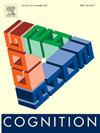语义视听一致性调节跨意识水平的生物运动的视觉敏感性
IF 2.8
1区 心理学
Q1 PSYCHOLOGY, EXPERIMENTAL
引用次数: 0
摘要
跨模态交互是否需要有意识地意识到多感官信息,或者它是否可以在没有意识的情况下发生,仍然是一个悬而未决的问题。在这里,我们研究了声音是否可以在不同的视觉意识水平上增强对语义匹配视觉刺激的检测灵敏度。在动态连续闪光抑制(CFS)过程中,我们对80名参与者进行了人体动作(行走、划船、锯切)的生物运动刺激,并测量了共同发生、语义匹配或不匹配动作声音对视觉灵敏度的影响(d ')。通过单独阈值刺激对比,我们区分了在机会水平上或在机会水平上检测运动的参与者。在所有实验条件下,可靠地检测到视觉运动的参与者对直立和倒立的生物运动表现出更高的敏感性。相比之下,在偶然水平(即在成功抑制过程中)检测视觉运动的参与者,仅在具有语义一致声音的试验中表现出这种直立优势。在整个样本中,声音对视觉灵敏度的影响随着参与者视觉检测性能的下降而增加,这揭示了听觉和视觉处理之间的系统权衡。我们的研究结果表明,听觉和视觉信息之间的语义一致性可以在视觉意识最小或不存在时选择性地调节生物运动感知,而更强大的视觉信号可以使生物运动感知独立于听觉输入。因此,语义一致的声音可能会影响视觉表征,作为视觉意识水平的一个功能。本文章由计算机程序翻译,如有差异,请以英文原文为准。
Semantic audio-visual congruence modulates visual sensitivity to biological motion across awareness levels
Whether cross-modal interaction requires conscious awareness of multisensory information or whether it can occur in the absence of awareness, is still an open question. Here, we investigated if sounds can enhance detection sensitivity of semantically matching visual stimuli at varying levels of visual awareness. We presented biological motion stimuli of human actions (walking, rowing, sawing) during dynamic continuous flash suppression (CFS) to 80 participants and measured the effect of co-occurring, semantically matching or non-matching action sounds on visual sensitivity (d′). By individually thresholding stimulus contrast, we distinguished participants who detected motion either above or at chance level.
Participants who reliably detected visual motion above chance showed higher sensitivity to upright versus inverted biological motion across all experimental conditions. In contrast, participants detecting visual motion at chance level, i.e. during successful suppression, demonstrated this upright advantage exclusively during trials with semantically congruent sounds. Across the whole sample, the impact of sounds on visual sensitivity increased as participants' visual detection performance decreased, revealing a systematic trade-off between auditory and visual processing. Our findings suggest that semantic congruence between auditory and visual information can selectively modulate biological motion perception when visual awareness is minimal or absent, while more robust visual signals enable perception of biological motion independent of auditory input. Thus, semantically congruent sounds may impact visual representations as a function of the level of visual awareness.
求助全文
通过发布文献求助,成功后即可免费获取论文全文。
去求助
来源期刊

Cognition
PSYCHOLOGY, EXPERIMENTAL-
CiteScore
6.40
自引率
5.90%
发文量
283
期刊介绍:
Cognition is an international journal that publishes theoretical and experimental papers on the study of the mind. It covers a wide variety of subjects concerning all the different aspects of cognition, ranging from biological and experimental studies to formal analysis. Contributions from the fields of psychology, neuroscience, linguistics, computer science, mathematics, ethology and philosophy are welcome in this journal provided that they have some bearing on the functioning of the mind. In addition, the journal serves as a forum for discussion of social and political aspects of cognitive science.
 求助内容:
求助内容: 应助结果提醒方式:
应助结果提醒方式:


